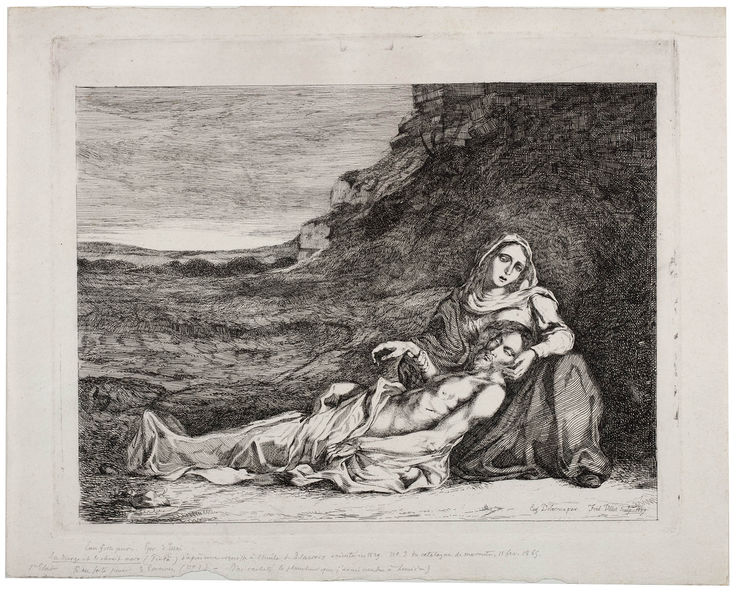Frédéric Villot (Liège 1809-1875 Paris)
Pietà, after Eugène Delacroix
signed ‘Eug. Delacroix pinx. Fréd Villot Sculp. 1837.’ (in the plate) and inscribed ‘Eau
forte pure. Epr. d’Essai./ La Vierge et la christ mort (Pietà) d’àpres une esquisse à l’huile
d. Delacroix execute au 1829. 3 du catalog de […], 11 fev. 1865./ 1 Eta Eau forte pure. 3
Epreuves (no 1) – J’ai racheté la planchet que j’avais vendu á Lem[…]’ (in pencil, recto)
etching
26.5 x 33 cm (plate); 30.1 x 38.1 cm (sheet)
undescribed by Nagler and Le Blanc, described by Béraldi, but without a number and
erroneously described as from 1839[1]
A very good impression, the sheet is in very good condition, with wide margins
Frédéric Villot was born in Liège in 1809, but he spent the majority of his career in Paris where he was active as an art historian, curator, art critic and artist. He was the curator of paintings at the Louvre from 1848-1861 and played a key role in cataloguing the museum’s collection. He published his findings on the collection in Notice des tableaux exposés dans les galeries du Musée National du Louvre, with the aim to systemically document and interpret works of the Louvre collection and increase public knowledge about it. Villot was a true cultural ambassador and was deeply involved in the intellectual and artistic circles of 19th century Paris. As Béraldi notes, the artist had a deep appreciation for art and music and he was one of the first collectors, perhaps the first, to embrace Japonisme. [2] Furthermore, Villot was close friends with some of the leading exponents of the Romantic movement, most imprtantly with Eugène Delacroix (1798-1863), whom had arrived in Paris in 1816 to study at the École des Beaux-Arts. Their close friendship is reflected in works by both artists. [3] Delacroix, for example, made a particularly informal and striking painted portrait of Villot in 1832 [4] and some eight years later he captured Villot’s portrait in a striking drawing, now in the Harvard Art Museums, Cambridge. [5] He furthermore portrayed Villot’s wife in an etching in 1833. [6] Villot, in turn, made a portrait print showing Delacroix after a drawing by the latter artist. [7]
The present print, which Béraldi considers a highpoint in the artist’s œuvre, is also after an invention by Delacroix. [8] Judging Villot’s autograph inscription along the lower edge of the sheet, he too considered it one of his more successful prints; the inscription notes that Villot bought the print back after he had sold it to a collector. Furthermore, Villot notes that this is the first of three proof impressions that me made of the print and that the painting by Delacroix was sold at an auction in 1865 (the present whereabouts of that painting are currently unknown).
Besides producing prints after Delacroix, Villot made a portrait of Richard Parkes Bonington [9] – another leading Romantic painter – after a drawing by the artist which is now in the British Museum. [10] Parkes Bonington was trained in France and spent several years working there, even sharing a studio with Delacroix for a short time. Like Delacroix and Bonington, Villot also drew inspiration from the work of Old Masters, such as Paolo Veronese (1528-1588) and Titian (1489/90-1576). However, his prints are predominantly
after his master, Eugène Delacroix.
Few prints by Villot are known today, probably due to the fact that only small numbers of impressions were ever printed. The two largest groups of works by the artist can now be found in the Musée National Eugène-Delacroix, Paris, which also holds a group of drawings attributed to the artist, and in the British Museum.
[1] H. Béraldi, Les Graveurs du XIXe siècle. XII. Saint-Marcel – Zwinger, Paris, 1885-1892, p. 245.
[2] Béraldi, op. cit., p. 244.
[3] Ibid., p. 245.
[4] The National Gallery, Prague, Inv. O4776.
[5] Inv. 1949.6.
[6] See for an impression, The Metropolitan Museum of Art, New York, inv. 57.583.
[7] See Béraldi, ibid., p. 245.
[8] Ibid., p. 245.
[9] See for an impression, The Metropolitan Museum of Art, New York, inv. 2020.258
[10] Inv. 1984,1006.28.

